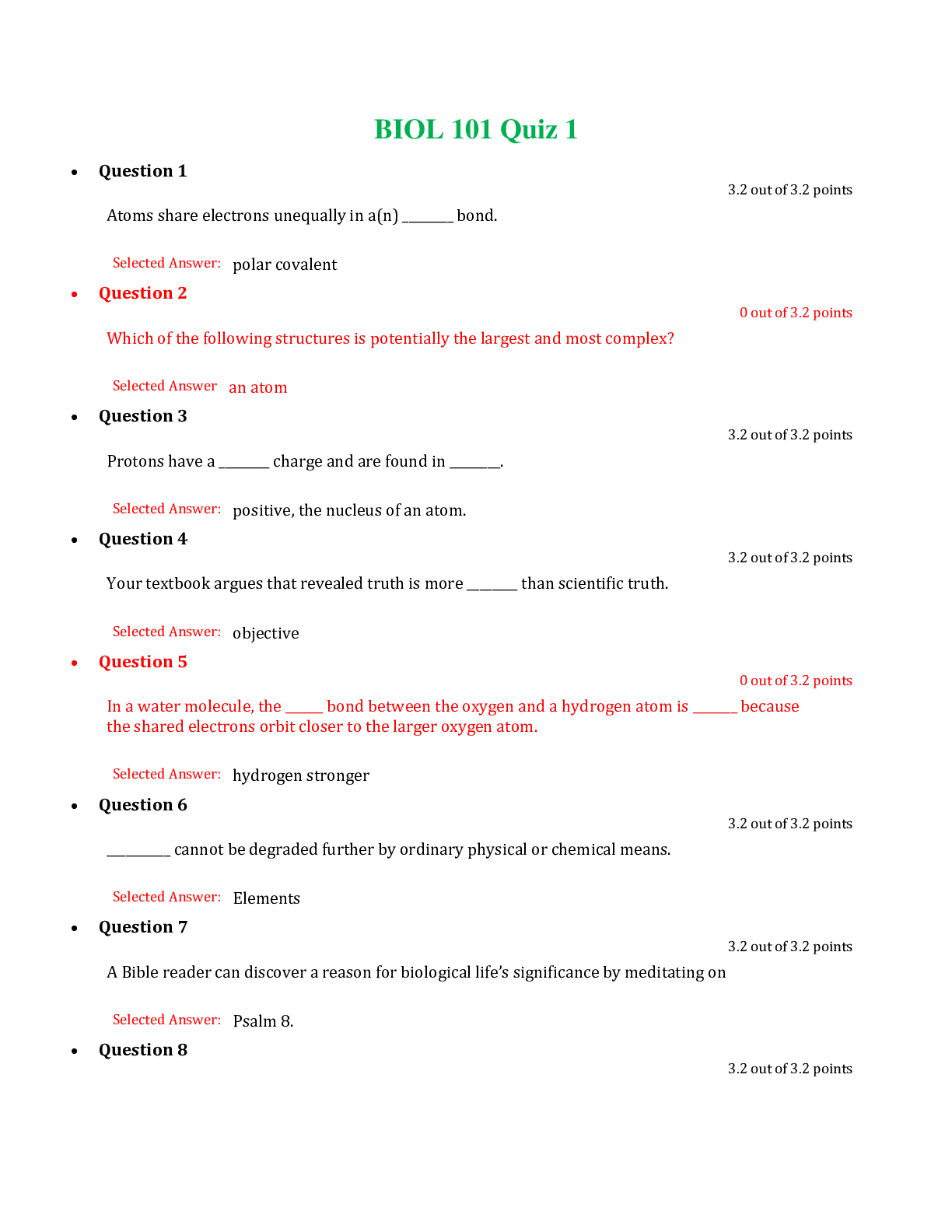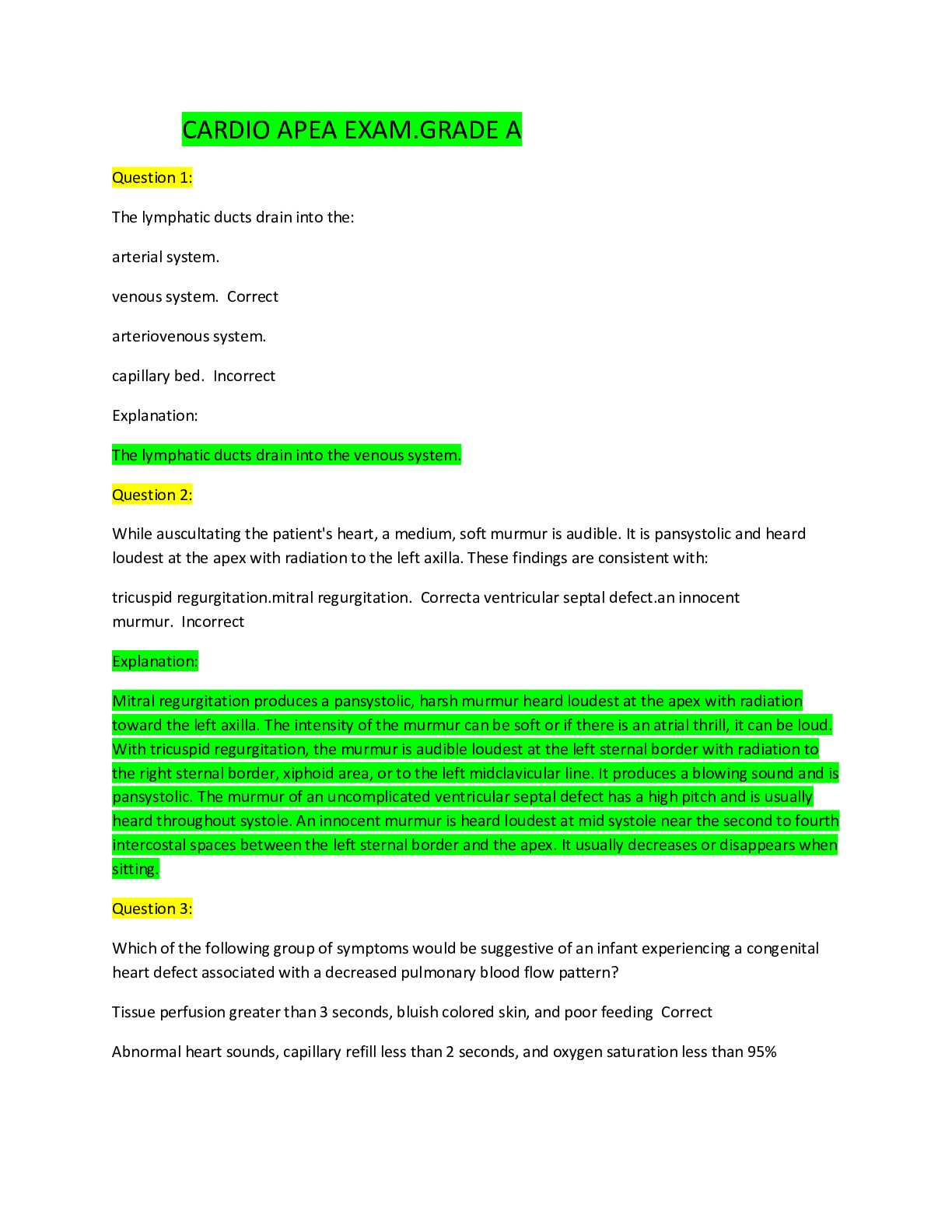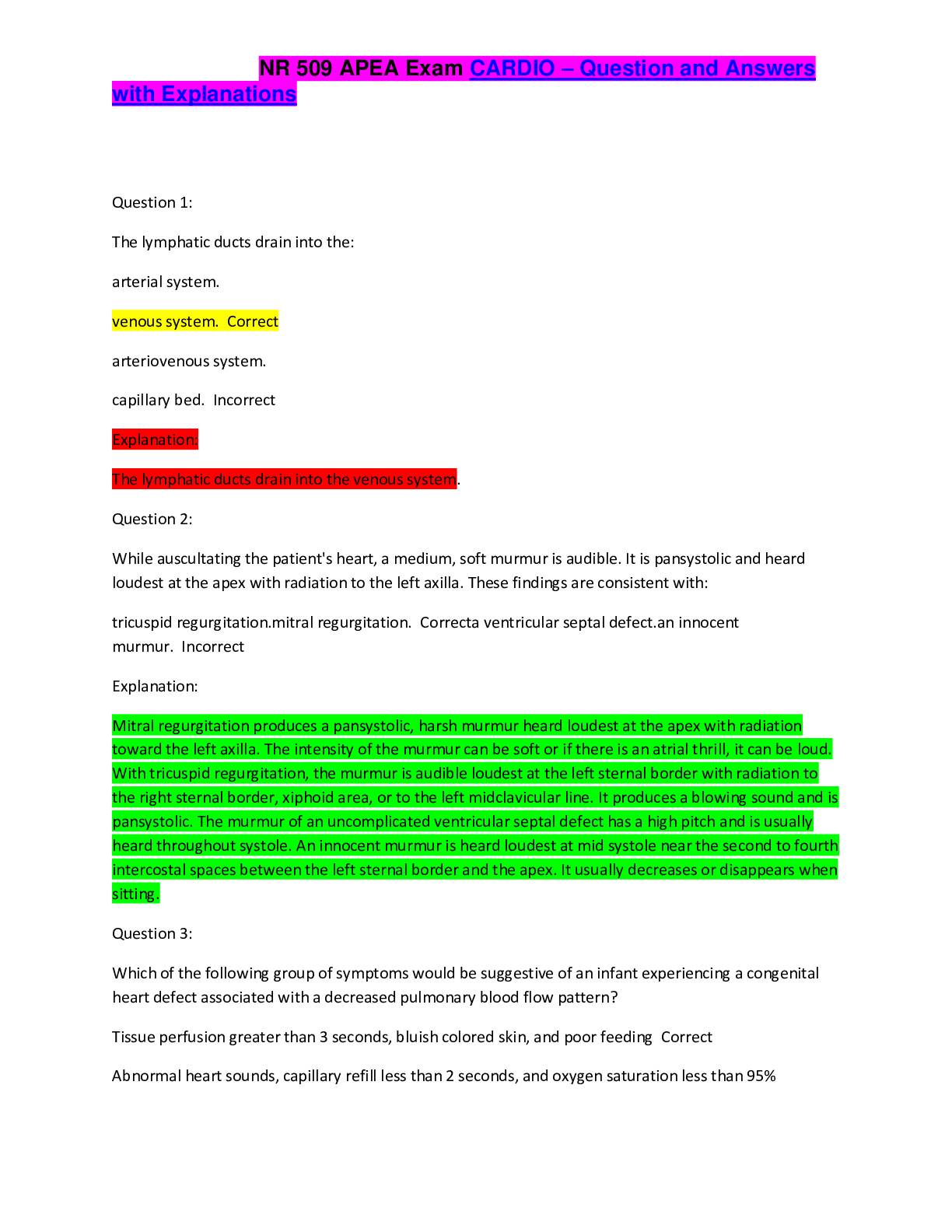*NURSING > EXAM > NR 509 APEA Pregnancy (updated) – Chamberlain College of Nursing | NR 509 APEA Pregnancy (updated) (All)
NR 509 APEA Pregnancy (updated) – Chamberlain College of Nursing | NR 509 APEA Pregnancy (updated) – Answers and Explanations_Rated A.
Document Content and Description Below
NR 509 APEA Pregnancy (updated) – Chamberlain College of Nursing Answers and Explanations Question: What is the standard instrument used to auscultate fetal heart tones? StethoscopeDoppler Correct ... Pre-natal monitorUltrasound Explanation: The Doppler fetal rate monitor is the standard instrument used for this measurement, and can detect the fetal rate (FHR) as early as 10 weeks gestation. Question: During pregnancy, what sound may be auscultated at the second or third intercostal space at the sternal border due to increased blood flow through the vessels? Diastolic murmur IncorrectSystolic murmurVenous hum CorrectBruit Explanation: A venous hum, or continuous mammary souffle that occurs during pregnancy is due to increased blood flow through normal vessels. The mammary souffle is commonly heard during late pregnancy or lactation. It is heard loudest in the second or third intercostal space at the sternal border, and is typically both systolic and diastolic, though only the systolic component may be audible. Question: If regular uterine contractions occur prior to 37 weeks gestation, this could be: a normal finding. Incorrectpreterm labor. Ce hypotensive syndrome. Explanation: Before 37 weeks, regular uterine contractions with or without pain and bleeding are abnormal, suggesting preterm labor. Question: Weight gain should be monitored during pregnancy. For a pregnant woman whose BMI is 18.5 - 24.9, the total weight gain should be: 11-20 pounds.15-25 pounds.25-35 pounds Correct28-40 pounds. Explanation: Weight gain should be closely monitored during pregnancy, as both excessive and inadequate weight gain are associated with poor birth outcomes. The pregnant woman who has a BMI of <18.5, should gain 28 - 40 pounds; BMI 18.5-24.9 should gain 25 - 35 pounds; BMI 25-29.9 should gain 15 - 25 pounds; and the obese pregnant woman should gain 11 - 20 pounds. Question: During pregnancy, a palpable softening of the cervical isthmus is noted. This finding is: Hegar's sign. CorrectChadwick's e nigra. Explanation: Hegar’s sign is the palpable softening of the cervical isthmus, the portion of the uterus that narrows into the cervix. Increased vascularity throughout the pelvis during pregnancy gives the vagina a bluish color, known as Chadwick’s sign. As the skin over the abdomen stretches to accommodate the fetus, purplish striae gravidarum (“stretch marks”) may appear. Linea nigra is a brownish black pigmented vertical stripe along the midline skin of the abdomen. Question: As tension on the abdominal wall increases with advancing pregnancy, the rectus abdominis muscles may separate at the midline of the abdomen. This finding is termed: striae asis recti. Correct Explanation: As tension on the abdominal wall increases with advancing pregnancy, the rectus abdominis muscles may separate at the midline: this is diastasis recti. If diastasis is severe, especially in multiparous women, only a layer of skin, fascia, and peritoneum may cover the anterior uterine wall, and fetal parts may be palpable through this muscular gap. Question: Facial edema in a pregnant woman after 20 weeks gestation, could be: a normal stive of preeclampsia. Correctrenal failure. Incorrectheart failure. Explanation: Facial edema in a pregnant woman after 20 gestational weeks may reflect preeclampsia and should be investigated. Question: Weight gain should be monitored during pregnancy. For a pregnant woman whose BMI is < 18.5, the total weight gain should be: 11-20 pounds.15-25 pounds.25-35 pounds28-40 pounds. Correct Explanation: Weight gain should be closely monitored during pregnancy, as both excessive and inadequate weight gain are associated with poor birth outcomes. The pregnant woman who has a BMI of <18.5, should gain 28 - 40 pounds; BMI 18.5-24.9 should gain 25 - 35 pounds; BMI 25-29.9 should gain 15 - 25 pounds; and the obese pregnant woman should gain 11 - 20 pounds. - - - - - - - - - - - - - - - - - - - - - - - - - - - - - - - - - - - - - Question: A form of milk produced by the mammary glands during late pregnancy is referred to as: witch's trum. Correctbreast ting milk. Explanation: A form of milk produced by the mammary glands during late pregnancy is referred to as colostrum. Question: When examining the pregnant patient, conjunctival pallor may indicate: a. Ctension. Explanation: In pregnant women, conjunctival pallor may indicate anemia. Question: When performing the first Leopold maneuver on a pregnant woman, if the fetal buttocks and head are not easily palpated at the fundus, the fetus is said to be in: vertical verse lie. Correctface x presentation. Explanation: The top of the uterus (fundus) is palpated to establish which end of the fetus (fetal pole) is in the upper part of the uterus. If either the head or buttocks (Breech) of the fetus is in the fundus, then the fetus is in vertical lie. Otherwise the fetus is most likely in transverse lie. If the cephalic prominence is on the same side as the small parts, then the fetus is in vertex presentation. If the cephalic prominence is on the same side as the back , then the head is extended and the fetus is in face presentation. Question: After 24 weeks gestation, auscultation of more than one fetal heart tone (FHT) in different locations with varying rates suggests: uterine growth ple gestation. Correct Explanation: After 24 weeks' gestation, auscultation of more than one FHT in different locations with varying rates suggests multiple gestation. Question: During pregnancy, a brownish black pigmented vertical stripe along the midline of the abdomen may appear. This finding is: Hegar's sign.Chadwick's e nigra. Correct Explanation: Linea nigra is a brownish black pigmented vertical stripe along the midline skin of the abdomen. As the skin over the abdomen stretches to accommodate the fetus, purplish striae gravidarum (“stretch marks”) may appear. Hegar’s sign is the palpable softening of the cervical isthmus, the portion of the uterus that narrows into the cervix. Increased vascularity throughout the pelvis during pregnancy gives the vagina a bluish color, known as Chadwick’s sign. Question: During the examination of a pregnant woman, knee and ankle deep tendon reflexes appear hyperreflexic. This finding could be suggestive of: tional lampsia. Correctan embolus. Explanation: During the examination of a pregnant woman, knee and ankle deep tendon reflexes appear hyperreflexic. This finding could be suggestive of preeclampsia. Question: Upon cervical examination of the pregnant woman, cervical erosion, erythema, and irritation are noted. These findings could be suggestive of: cervical cancer.a non-pregnant citis. Correctbacterial vaginosis. Explanation: Cervical erosion, erythema, discharge, or irritation might suggest cervicitis and warrants investigation for sexually transmitted infections (STIs). A pink cervix suggests a non-pregnant state. [Show More]
Last updated: 2 years ago
Preview 1 out of 22 pages

Buy this document to get the full access instantly
Instant Download Access after purchase
Buy NowInstant download
We Accept:

Reviews( 0 )
$19.00
Can't find what you want? Try our AI powered Search
Document information
Connected school, study & course
About the document
Uploaded On
Aug 24, 2020
Number of pages
22
Written in
Additional information
This document has been written for:
Uploaded
Aug 24, 2020
Downloads
0
Views
88


























